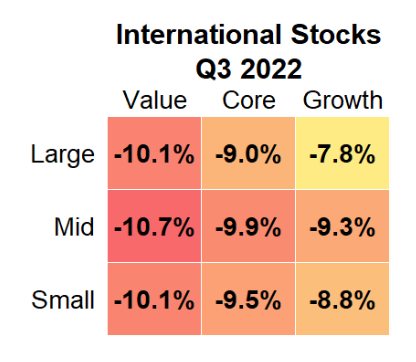FROM OUR INVESTMENT COMMITTEE: Q3 2022 in Perspective
MODERNIST’S ASSET CLASS INVESTING PORTFOLIOS ARE STRATEGICALLY INVESTED WITH A FOCUS ON LONG-TERM PERFORMANCE OBJECTIVES. PORTFOLIO ALLOCATIONS AND INVESTMENTS ARE NOT ADJUSTED IN RESPONSE TO MARKET NEWS OR ECONOMIC EVENTS; HOWEVER, OUR INVESTMENT COMMITTEE EVALUATES AND REPORTS ON MARKET AND ECONOMIC CONDITIONS TO PROVIDE OUR INVESTORS WITH PERSPECTIVE AND TO PUT PORTFOLIO PERFORMANCE IN PROPER CONTEXT.
During the third quarter, global stock and bond markets continued their downward trends from the previous quarter. The S&P 500 index extended its decline from the first half of the year by closing the quarter with its worst month since March 2020. Bond markets also continued to decline, fueled by the expectation of continued rate hikes and elevated inflation readings. Growing concerns that central banks around the globe will be willing to push economies into recession to stop inflation resulted in negative performance for the quarter across all major asset classes.
For the quarter, U.S. stocks (as measured by the Russell 3000 index) lost 4.5%, and non-U.S. developed market stocks (as measured by the MSCI World Ex U.S. IMI Index) lost 9.2%. Emerging market stocks (as measured by the MSCI Emerging Markets IMI Index) lost 10.8%.
The U.S. dollar index, a measure of the value of the U.S. dollar relative to a basket of foreign currencies, increased during the quarter—by 7.1%. Over the past 12 months, the U.S. dollar increased by 19.0%. The increase in the dollar is a headwind to non-U.S. investments (International + Emerging Markets) held by U.S. investors.
U.S. interest rates increased during the quarter as the Federal Reserve raised the target range of the federal funds rate from 1.50%-1.75% to 3.00%-3.25% with two rate hikes of 0.75% in July and September. However, markets have currently priced in the expectation of four to five additional rate hikes during the remainder of 2022 with an implied target range of 4.00%--4.25% by year’s end.
U.S. Economic Review
The final reading for second-quarter annualized GDP was -0.6% meaning economic output contracted for the second consecutive quarter in 2022. And while two consecutive negative readings historically precede the official declaration of a recession, the National Bureau of Economic Research, the organization responsible for declaring recessions, has yet to do so.
The unemployment rate ticked up slightly to 3.7% in August. This coincides with a tight labor market that might be showing early signs of loosening; there were approximately 10.4 million job openings (down from 11.4 million in April) for six million unemployed workers at the end of August.
Domestic inflation was 4.9% in August, as the Fed's preferred gauge of overall inflation, the core personal consumption expenditures (PCE), remained well above the Fed’s long-term target average of 2.0%. Headline inflation, as measured by the consumer price index (CPI), closed out August at 8.3%. The CPI and PCE readings tend to differ primarily because CPI includes volatile categories like food and energy in its methodology while core PCE does not.
Financial Markets Review
Domestically, all size and style equity categories were down during the quarter. International developed stock markets also posted negative performance, and, for U.S. investors, returns were negatively impacted during the quarter by the strengthening U.S. dollar.
U.S. small-cap stocks were the best performing asset class, and U.S. REITs (Real Estate Investment Trust) were the worst performing asset class during the quarter.
The economic uncertainty caused by continuing war in Ukraine, high inflation and the Fed’s ongoing rate-hike campaign caused U.S. and global bonds to lose more than 1% for the quarter and move in the same direction as stocks.
In the U.S., small-cap stocks declined less than large-cap stocks in all style categories. Growth stocks declined less than value stocks in all size categories. Among the nine style boxes, small- cap growth stocks performed the best and large-cap value stocks had the lowest return during the quarter.
Source: Morningstar Direct, October 2022. U.S. markets represented by respective Russell indexes for each category (Large: Russell 1000, Value, and Growth, Mid: Russell Mid Cap, Value, and Growth, Small: Russell 2000, Value, and Growth).
In developed international markets, large-cap stocks declined less than small-cap stocks in all style categories for the quarter. Like in the U.S., value stocks declined less than growth stocks in all size categories. Among the nine style boxes, international large-cap value stocks performed the best and international small-cap growth stocks had the lowest return during the quarter.
A diversified index mix of 60% stocks and 40% bonds would have lost 5.1% during the quarter.
Source: Morningstar Direct, October 2022. International markets represented by respective MSCI World EX USA index series (Large: MSCI World EX USA Large, Value and Growth, Mid: MSCI World Ex USA Mid, Value, and Growth, Small: MSCI World Ex USA Small, Value, and Growth).





